Staff Reporter
ITANAGAR, Apr 21: The standing committee of the National Board for Wildlife (NBWL) has sought suggestions from the National Tiger Conservation Authority (NTCA) regarding the proposed realignment of two stretches of the Miao-Vijoynagar road that passes through the Namdapha Tiger Reserve (NTR).
The NBWL, which held a meeting in this regard on 7 April, advised the NTCA to submit its suggestions within a month from 20 April.
It also said that the chief wildlife warden of the Arunachal government should constitute a monitoring committee, comprising members from the NTR, the NTCA’s regional office and the Wildlife Institute of India’s tiger cell to oversee the project and ensure that it is implemented in strict adherence to the suggested mitigation measures.
The minutes of the NBWL meeting, which was released on Monday, read that the state government has requested for realigning the two stretches of the road “to ensure negotiable condition of road” and better implementation of the NTR’s tiger conservation plan (TCP).
Only about 10 percent of the total protected area is accessible for protection and management, for want of road communication inside the park. “The TCP for the protected area stresses on creation, improvement and maintenance of roads for effective protection and management of the tiger reserve,” the minutes read.
It stated that the proposed realignment would provide “stable sub-grade for the stability of the road. Therefore, it will help in continuous movement of vehicles for the purpose of effective protection and management.”
“Without realignment at the two stretches,” it said, “the road would virtually be un-utilizable due to unstable soil condition in these stretches.”
The area of the existing road in stretch 1 (between 32 miles to 53 miles) and stretch 2 (between 61 miles and 64 miles) will be “eco-restored by way of afforestation/habitat improvement, as per the TCP,” the minutes read.
Meanwhile, the IGF (WL) stated that the NTCA has recommended the project with certain conditions and mitigation measures in place.
As realignment would entail making gaps in the canopy by removal of vegetation, which would be detrimental to arboreal species like gibbons and flying squirrels that need continuous canopy, “the realignment should not be done where critically required due to engineering issues,” the minutes stated.
As per the proposal, the realignment of the road will primarily be in the valley habitats that are vital for wildlife. “Therefore, realignment in valley habitats may be avoided as much as possible,” it said.
It also said that the technical feasibility of the realignment should be worked out by the user agency in consultation with NTR management and the NTCA, in the interest of wildlife.
“Moreover, if this proposed alternate alignment is not at all feasible technically, then realignment should only be done where critically required due to engineering issues and not along the entire currently proposed length of the alignments, with adequate underpasses for ensuring wildlife connectivity,” it said.
The minutes also stated that the exact dimensions, design and placement of the underpasses should be finalized after a joint survey by the user agency and the state’s forest department, in consultation with the NTCA and the tiger cell officials.
“Once the realignment is in place, the existing alignments at 32 miles, 61 miles should be entirely decommissioned and allowed to be taken over by the forest. No existing drainage should be blocked due to construction of the road,” it said.
“The proposed road should be used mainly for national defence, patrolling by forest department staff, and by the local tribal communities inhabiting within the tiger reserve,” the minutes read.





